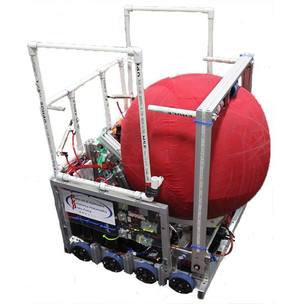|
FRC team 225, TechFire, presents our 2014 robot, "DJ Fireball". The "DJ" stands for David J. Stickler, a TechFire mentor and NRG Energy Vice President who tragically passed away this past fall. He was a great supporter of FIRST. TechFire is sponsored by PRESIDIO Networked Solutions, NRG Energy, Penn-Air & Hydraulics, St. Onge Company, Fred Dallmeyer Fund of York County Community Foundation, Leidos, Coupling Corporation of America, Lockheed Martin, ParenteBeard, Vicente Rojas Family, Tekgard Inc., JMT Engineering, Weldon Solutions, the Engineering Society of York, and Penn State York. |
Robot:
• 117.5 lb without battery/bumpers
• 27.5” long x 28.125” wide x 48” tall
• Thomas 215ADC38/12 compressor for air generation and 9 tanks for air storage
Drive:
• Eight 4”x1” VexPRO Traction Wheels with nitrile roughtop tread
• VersaChassis west coast drive system driven by #25 chain
• 80/20 brace in middle of the frame for extra rigidity
• 4 CIM motors and 2 Mini-CIM motors driven through VexPRO 3 CIM Ball Shifters
• Geared for speeds of ~4.5 ft/s and 11 ft/s
Collector Arm:
• Rotation actuated by 2 ¾” bore and 3” stroke cylinders
• 3 positions determined by cylinder extensions – one position where the collector secures the ball, one position for shooting, and one position for collecting
• 80/20 collector design keeps collector rigid, low-profile, and easy to tune
• RS550 through a 10:1 VersaPlanetary powers four 2 3/8” BaneBots wheels for manipulating the ball
• Potentiometer tracks arm position
• Arm used for collecting the ball, catching a bouncing or thrown ball, centering the ball for shooting, passing to other robots, and low goal-scoring
• Inspired by many 3-day robots (Ri3D, team JVN, team Copioli)
Catapult:
• Ball launched with 2 2.5” bore and 5” stroke cylinders (Inspired by a 987 prototype--thanks for sharing your prototyping videos!)
• Pneumatic latch allows cylinders to “pre-charge” prior to release, creating an air spring
- Changing the time between pre-charge and latch release provides a variety of launching strengths for different distances from the goal or over the truss (thanks for the idea, 842!)
• Catapult used for launching the ball over the truss and launching the ball into the high goal
• Ball centering control using a photo eye and the collector roller
Catching/Human Player Assist Device:
• Opened and closed with by 2 3” pneumatic cylinders
• Opens on three sides of the robot
• PVC construction allows catching device to flex, dampening impacts with flying balls and other robots
• Catching device mostly used for inbounding from human players—the catching device doesn’t catch robot truss shots very well
• Catching device applies pressure to the sides of the ball after acquisition, allowing for a more-consistent shot due to consistent placement
• Photo eye detects balls thrown into the robot from human players and other robots, automatically closing the catching device when a ball is sensed
Programming
• Homebrewed java program inspired by Cheesy Vision for detecting the hot goal (thanks 254!) (this was done by our fantastic programmer Andrew Lobos while riding to MAR Champs)
• Running a variant of Cheesy Drive (again, thanks 254!)
• 2-ball hot goal autonomous (Also done by Andrew—he did a great job with this, getting it after about four iterations between practice matches)
• 1-ball hot goal autonomous
• 2-ball (1 hot, 1 not) autonomous (for if there is a goalie)
Results
• Springside-Chestnut Hill Winner (from #5 alliance, alliance captain)
• Lenape Quarterfinalist (from #2 alliance, alliance captain)
• Greater DC Winner (from #1 alliance, alliance captain)
• MAR Championship Semifinalist (from #3 alliance, alliance captain)

